Digital PR is the process of building and managing a brand’s reputation and visibility through online platforms, channels, and strategies. It’s a spinoff of traditional public relations, which relies on legacy media to build client relationships, manage brand reputation, and shape public perceptions.
Digital PR is built on the core principles of traditional PR, which include storytelling, long-term reputational building, crisis management, and message control. In today’s digital-first world, digital PR is more effective than traditional PR because it provides global reach and allows direct audience engagement.
While digital PR was mainly reserved for big brands due to high costs, it is now accessible to brands of all sizes because online PR campaigns can be optimized to business size and budget. This guide breaks down everything you need to know about digital PR in 2025.
What is digital PR?
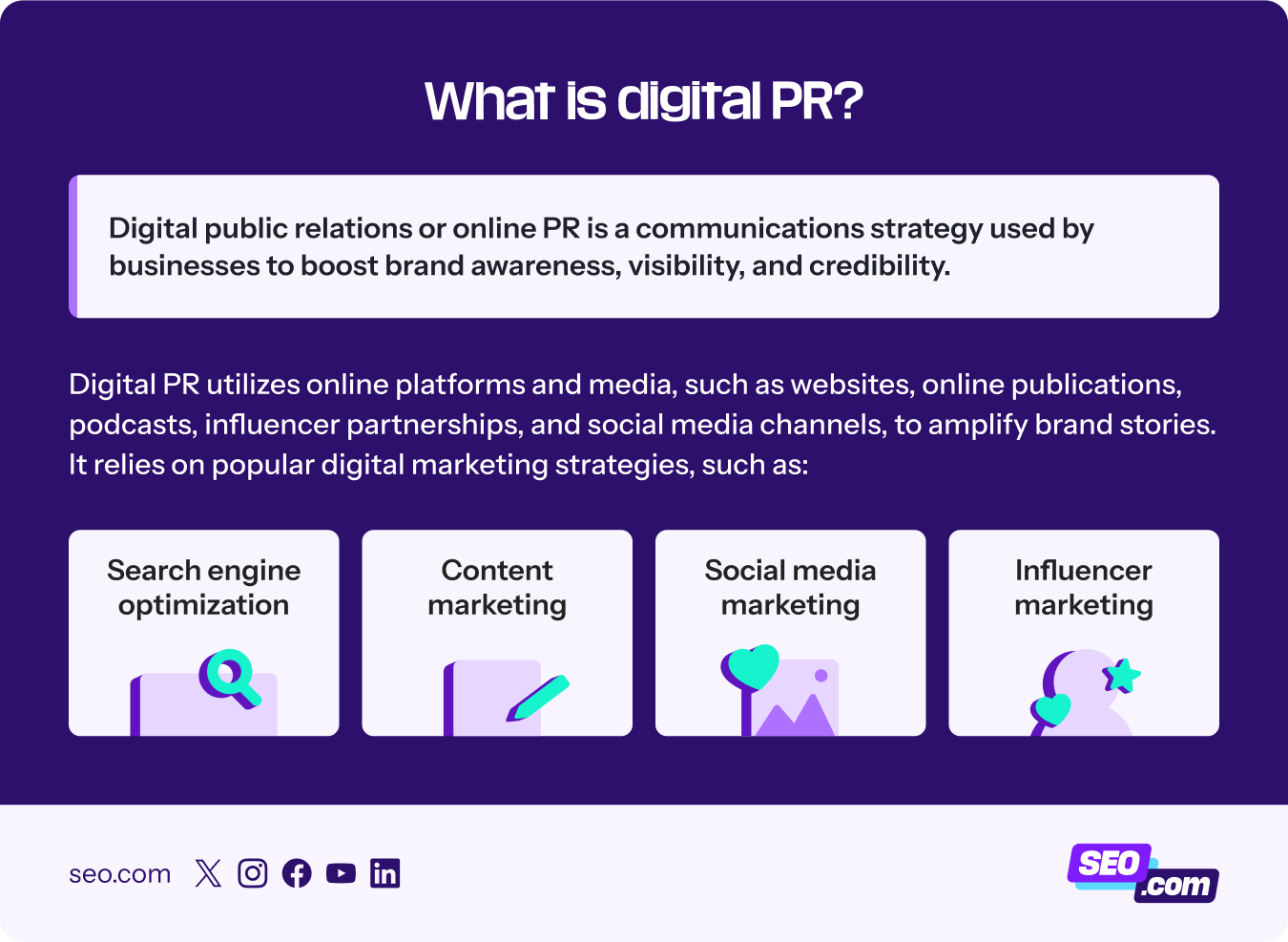
By definition, digital public relations or online PR is a communications strategy used by businesses to boost brand awareness, visibility, and credibility. It aims to help brands communicate proactively and reactively with their target audience at any time and from anywhere.
Digital PR utilizes online platforms and media, such as websites, online publications, podcasts, influencer partnerships, and social media channels, to amplify brand stories. It relies on popular digital marketing strategies, such as:
- Search engine optimization (SEO)
- Content marketing
- Social media marketing
- Influencer marketing
High-quality backlinks, positive media mentions, and authoritative digital media coverage are some examples of digital PR activities that replace the need to build relationships with publishers and journalists, which is vital to traditional PR.
When do brands need digital PR?
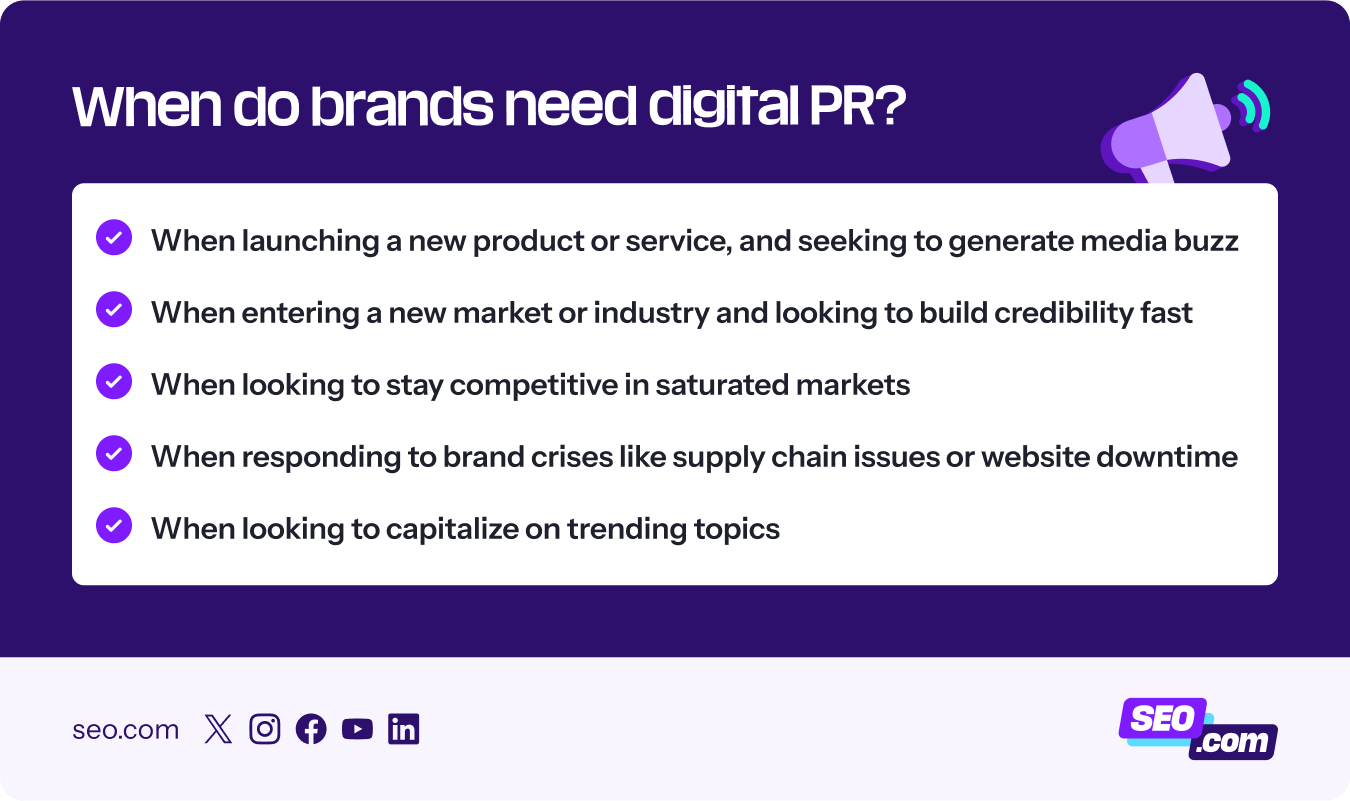
Digital PR is necessary for businesses of all sizes and at all growth levels. It’s more effective than simple advertising because it helps gain audience trust and authority online.
There are instances when digital PR is the best choice for your business, including:
- When launching a new product or service, and seeking to generate media buzz
- When entering a new market or industry and looking to build credibility fast
- When looking to stay competitive in saturated markets
- When responding to brand crises like supply chain issues or website downtime
- When looking to capitalize on trending topics
A good example of a digital PR campaign is the Spotify Wrapped campaign, which the digital music service launches in December of every year. The campaign highlights every user’s most-streamed songs, artists, and genres, turning real-time data into entertainment.
The results of these campaigns are impeccable and include wide media coverage on online publications such as Billboard and BBC, extensive social sharing, and backlinking to strengthen domain authority. Investing in digital PR services can help your brand achieve similar reach and impact with a strategic, professional approach.
Benefits of digital PR
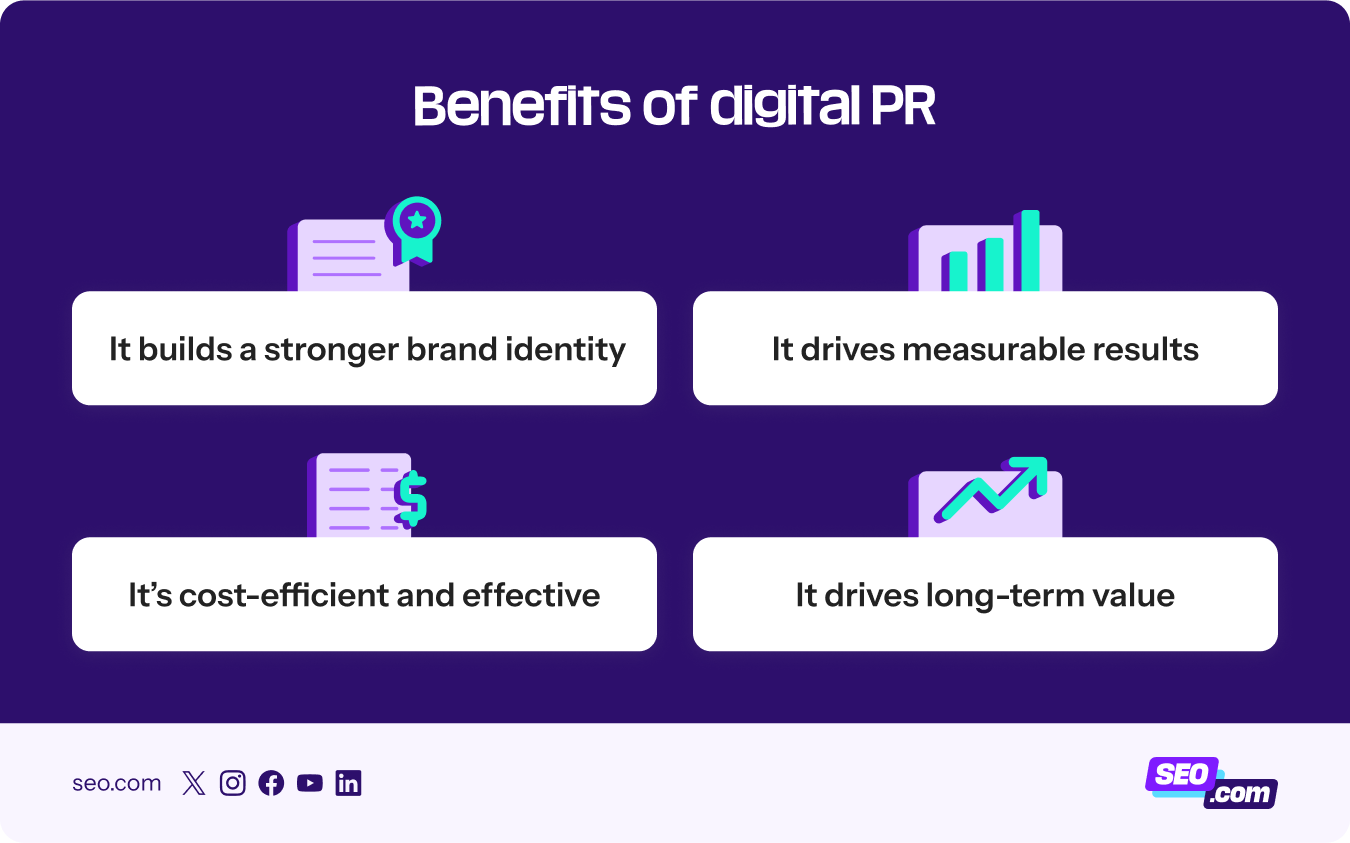
Digital PR drives many benefits for businesses that go beyond the limits of traditional PR. Most of the benefits can be attributed to the fact that this online public relations approach is measurable, scalable, and more agile.
The following are the main benefits of digital PR.
1. It builds a stronger brand identity
Digital PR enhances brand awareness and visibility by ensuring your brand shows up across multiple touchpoints, including online news outlets, search results pages (SERPs), podcasts, and social platforms.
Leveraging influencer collaborations and endorsements from digital publications can also build credibility and trust by acting as third-party verifications that make your brand more authoritative.
With digital PR, you can tell a consistent story about your brand across channels, strengthening brand recognition and recall. You can also shape the perception of your brand and position yourself exactly where audiences expect to see you.
2. It drives measurable results
The greatest challenge of traditional PR is measuring exact outcomes. You often have to rely on estimates, because how can you calculate the exact number of people who listen to a radio ad or see a billboard? Moreover, how can you tie those numbers to your return on investment?
However, with digital PR, you can measure reach and impact by tracking traffic, clicks, conversions, engagement, and backlinks. You can analyze these real-time data and use it to optimize campaigns and prove return on investment (ROI) for each campaign.
3. It’s cost-efficient and effective
Digital PR boasts lower information distribution costs since it’s done instantly through websites, online publications, social media, and emails. This is significantly cheaper than traditional PR distribution done via press events, media tours, print placements, TV, and radio placements.
Digital PR’s cost efficiency is also based on the fact that it supports multiple goals, like building brand awareness, improving SEO, increasing website traffic, and strengthening reputation. The longer campaign lifespan and lasting footprint of online PR make every dollar invested in it go further.
4. It drives long-term value
Traditional PR provides fleeting media coverage on outlets like newspapers and TV, meaning that even though people may read about you today, tomorrow those outlets will be covering different brands. However, with digital PR, your brand stories are highlighted on online platforms such as websites and social media platforms, where they don’t easily disappear with time.
When you produce evergreen content, it remains relevant and valuable long after it’s published, ensuring stronger domain authority and site visibility. And nothing will stop your target audience from sharing your content for ages after publishing, provided it is helpful and high-quality.
Digital PR strategies
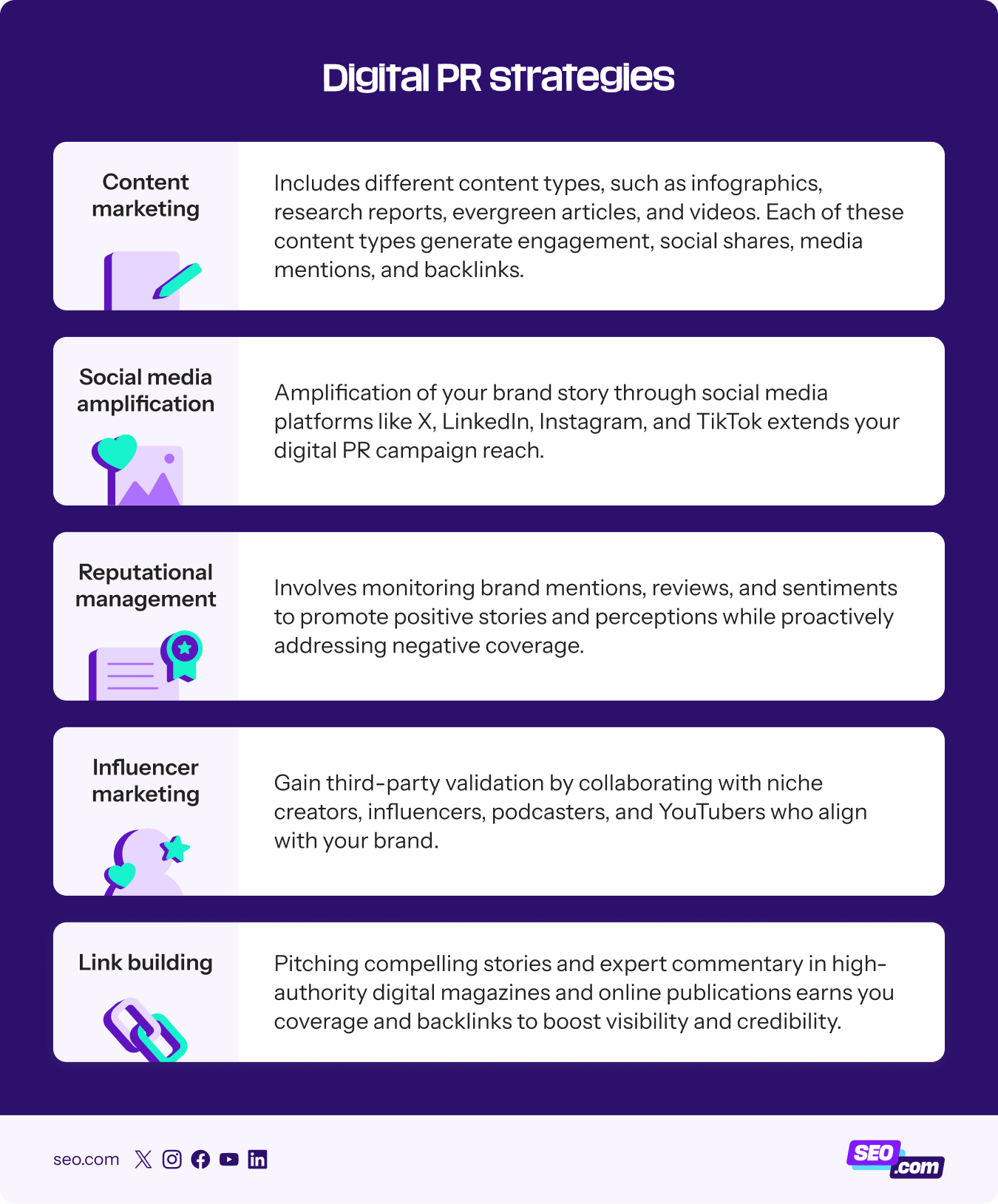
Digital PR relies on the most effective digital marketing strategies to build long-term value and impact. These strategies combine creativity, storytelling, and relationship-building to build your brand’s online visibility and credibility:
- Content marketing: Content is the backbone of digital PR. It includes different content types, such as infographics, research reports, evergreen articles, and videos. Each of these content types generate engagement, social shares, media mentions, and backlinks.
- Social media amplification: Amplification of your brand story through social media platforms like X, LinkedIn, Instagram, and TikTok extends your digital PR campaign reach. Additionally, it sparks conversations and boosts engagement.
- Reputational management: Online reputational management involves monitoring brand mentions, reviews, and sentiments to promote positive stories and perceptions while proactively addressing negative coverage.
- Influencer marketing: Gain third-party validation by collaborating with niche creators, influencers, podcasters, and YouTubers who align with your brand. These collaborations expand your reach and create more authentic connections than brand-led messaging.
- Link building: Pitching compelling stories and expert commentary in high-authority digital magazines and online publications earns you coverage and backlinks to boost visibility and credibility.
How to start a digital PR campaign
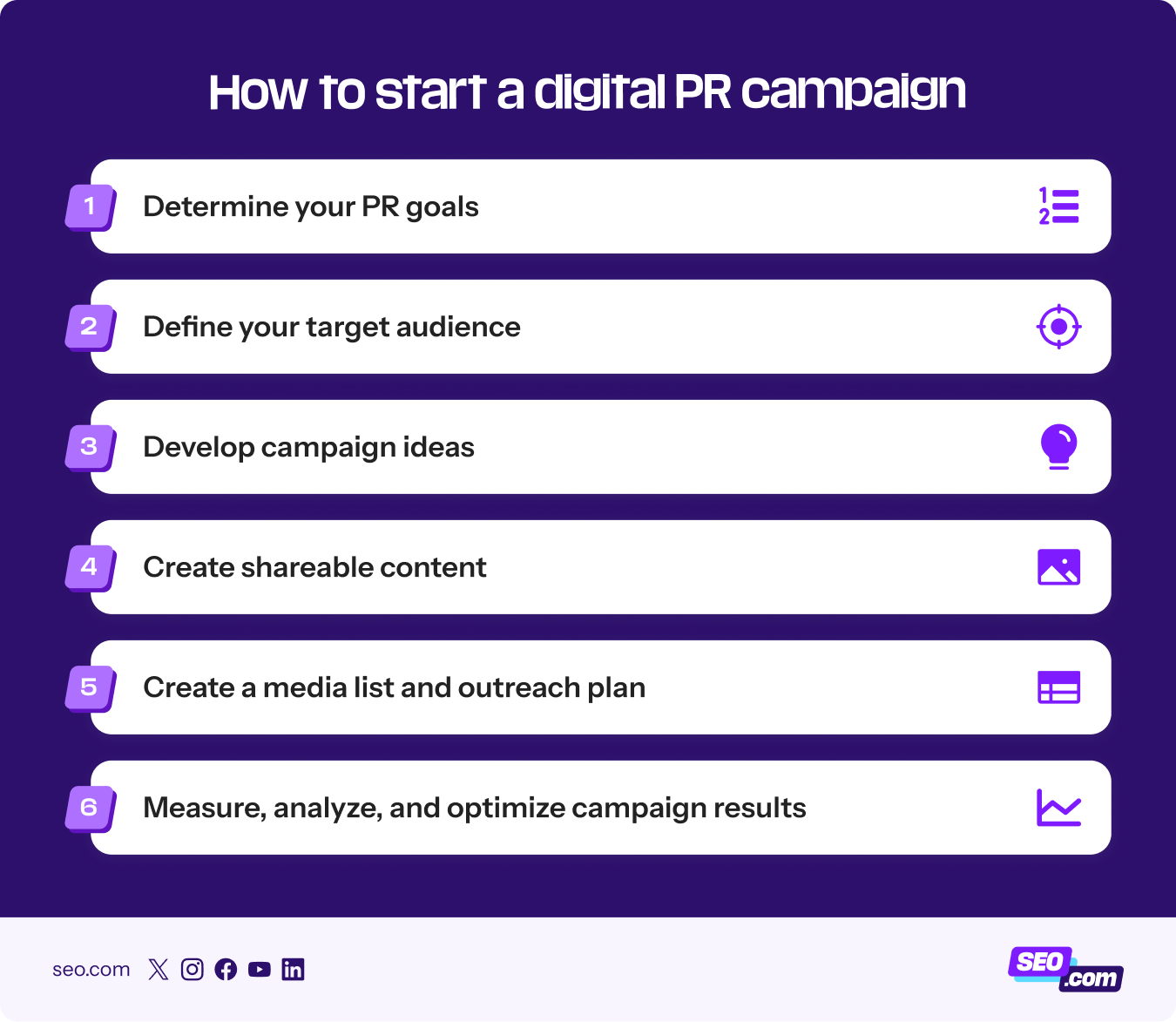
Launching a successful PR campaign takes more than sending out press releases — it requires strategic planning and numerous actionable steps. Here’s a step-by-step guide for developing a successful digital PR campaign.
Step 1: Determine your PR goals
Start by asking yourself, “Why do I need a digital PR campaign?” Defining exactly what you need shapes your strategy and helps you determine how you’ll measure success. Some goals you should explore include building brand awareness, earning backlinks for SEO, driving website traffic, and improving brand reputation.
Step 2: Define your target audience
Be clear on whom you want to reach, their pain points, interests, and the platforms you’ll find them on. That ensures you create campaigns that resonate with them. So ask yourself, “Who are my customers? Which influencers have access to my target audience? Which publications are relevant to my campaign?”
Step 3: Develop campaign ideas
Developing successful and shareable digital PR campaign ideas involves finding a balance between what your audience cares about and what aligns with your brand’s values and expertise. You should explore different campaign idea formats before selecting the most appropriate one.
Some popular digital campaign formats include social impact campaigns and data-driven surveys.
Step 4: Create shareable content
Maximizing digital PR impact involves creating shareable content, such as blog posts, research papers, infographics, or press releases. Shareable content is high-quality, relevant, engaging, and designed for easy distribution. Taking a multi-format approach to content design maximizes reach and fuels long-term visibility.
Step 5: Create a media list and outreach plan
Building a targeted media list and outreach plan ensures your content reaches a broader audience. You need a well-curated list of journalists, influencers, bloggers, creators, and podcasters who care about your brand and are the most likely to share it with your target audience.
Step 6: Measure, analyze, and optimize campaign results
Digital PR provides you with access to performance, engagement, and conversion metrics. The most successful campaigns involve analyzing performance to help refine campaigns in real-time and prove ROI. It also helps to identify strengths and weaknesses to inform future campaigns.
AI and the future of digital PR
AI is a powerful tool for enhancing digital PR strategy, efficiency, and personalization. It’s a powerful tool that makes digital PR campaigns more creative, targeted, and measurable. There are various ways of integrating AI into digital PR campaigns, including:
- Tracking brand mentions and providing instant insights
- Analyzing large datasets to uncover consumer behaviors and industry trends
- Personalizing outreach recommendations based on past coverage
- Supporting content creation efforts by assisting with generating ideas, drafting the content, and optimizing it
Check if your site appears in AI Results
Want to check if your site is appearing in Google AI Overviews? Use our free AI Overview Checker to find out! Our AI Overview Checker also displays some crucial information for how organic results are informing the AI Overviews, and how your site can improve.
Digital PR FAQs
Here are some answers to the most commonly asked questions about digital PR.
What is digital PR, and how is it different from traditional PR?
Digital PR is the modern-day evolution of traditional public relations. It leverages websites, online publications, podcasts, and social media to connect with audiences and shape brand perceptions. It’s grounded on the same core principles as traditional PR, but it’s faster, provides wider reach, and is more measurable.
How does digital PR impact SEO?
Digital PR is a powerful SEO driver. It sends signals to search engines via mentions, backlinks, and media coverage, leading to higher rankings. Digital PR strategies also pass domain authority and establish you as an authoritative, credible, and trustworthy expert, which boosts your organic search presence.
Can AI be used in a digital PR strategy?
Yes. AI can transform how brands plan, execute, and measure digital PR campaigns. OmniSEO® is an example of an AI tool that helps boost, monitor, and manage your brand’s visibility across different search engines, including Google, Bing, ChatGPT, Perplexity, and Meta AI.
What are the best digital PR tools to use?
OmniSEO® helps brands uncover trending topics, identify search opportunities, and create content that earns media coverage and backlinks. Its AI-driven insights ensure campaigns are newsworthy and optimized for long-term SEO visibility.
How do I measure the success of a digital PR campaign?
Digital PR provides measurable results that can be tracked through earned backlinks, search visibility, website traffic, social engagement rates, media mentions, leads, and conversions.
Future-proof your digital PR strategy with OmniSEO®
The future of PR requires measurable visibility, as is the case with traditional PR. With OmniSEO®, you can track how your brand appears on social media, AI-powered search engines, and other digital channels while also monitoring earned media mentions.
In short, this tool shows how PR efforts translate into AI search visibility and provides opportunities to optimize campaigns for cross-channel performance. It ensures your campaigns drive growth and not just buzz. Schedule an OmniSEO® demo today to see how we can future-proof your digital PR strategy with our tool!

Future-Proof Your SEO Strategy with OmniSEO®
Goodbye search engine optimization, hello search everywhere optimization.



Future-Proof Your SEO Strategy with OmniSEO®
Goodbye search engine optimization, hello search everywhere optimization.

Future-Proof Your SEO Strategy with OmniSEO®
Goodbye search engine optimization, hello search everywhere optimization.
Writers




